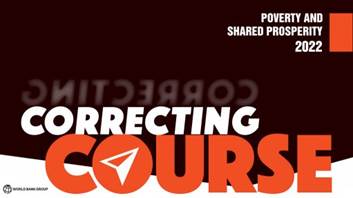“Poverty and Shared Prosperity 2022: Correcting Course”

Disclaimer: Copyright infringement not intended.
Context
- According to a new World Bank report, titled “Poverty and Shared Prosperity 2022: Correcting Course”, the Covid pandemic has been the biggest setback to global poverty alleviation in decades.
Details
- The World Bank's Poverty and Shared Prosperity series provides the latest estimates and trends in global poverty and shared prosperity.
- Poverty and Shared Prosperity is a biennial series that explores a central challenge to poverty reduction and boosting shared prosperity, assessing what works well and what does not in different settings. By bringing together the latest evidence, this corporate flagship report provides a foundation for informed advocacy around ending extreme poverty and improving the lives of the poorest in every country in the world.
- The 2022 edition provides the first comprehensive look at the landscape of poverty in the aftermath of an extraordinary series of shocks to the global economy.
Findings of the Report
Poverty by 2030
- The world is unlikely to meet the goal of ending extreme poverty by 2030 absent history-defying rates of economic growth over the remainder of this decade.
COVID-19
- COVID-19 dealt the biggest setback to global poverty-reduction efforts since 1990 and the war in Ukraine threatens to make matters worse.
- The pandemic pushed about 70 million people into extreme poverty in 2020, the largest one-year increase since global poverty monitoring began in 1990. As a result, an estimated 719 million people subsisted on less than $2.15 a day by the end of 2020.
The year 2020
- 2020 marked a historic turning point—when the era of global income convergence yielded to divergence. The poorest people bore the steepest costs of the pandemic: income losses averaged 4% for the poorest 40%, double the losses of the wealthiest 20% of the income distribution. Global inequality rose, as a result, for the first time in decades.
The new Global Extreme Poverty Line
- The new report is the first to provide current and historical data on the new global extreme-poverty line, which has been adjusted upward to $2.15 a day to reflect the latest 2017 purchasing-power-parity data.
- Extreme poverty fell dramatically across the world from 1990 through 2019, the latest year for which official data are available. But progress slowed after 2014, and policymakers now confront a tougher environment: Extreme poverty is concentrated in parts of the world where it will be hardest to eradicate—in Sub-Saharan Africa, in conflict-affected areas, and in rural areas.
- Sub-Saharan Africa now accounts for 60% of all people in extreme poverty—389 million, more than any other region. The region’s poverty rate is about 35%, the world’s highest.
Uneven Economic Recovery
- Government spending and emergency support helped avert even bigger increases in poverty rates, the report showed, but the economic recovery had been uneven, with developing economies with fewer resources spending less and achieving less.
Way Ahead
- Countries should boost cooperation, avoid broad subsidies, focus on long-term growth and adopt measures such as property taxes and carbon taxes that could help raise revenue without hurting the poorest people.
National Policy Reforms
National policy reforms can help restart progress in reducing poverty, the report finds. Stepped-up global cooperation will also be necessary. In fiscal policy, governments should act promptly on three fronts:
- Avoid broad subsidies, increase targeted cash transfers: Half of all spending on energy subsidies in low- and middle- income economies goes to the richest 20 percent of the population who consume more energy. Cash transfers are a far more effective mechanism for supporting poor and vulnerable groups.
- Focus on long-term growth: High-return investments in education, research and development, and infrastructure projects need to be made today. In a time of scarce resources, more efficient spending and improved preparation for the next crisis will be key.
- Mobilize domestic revenues without hurting the poor. Property taxes and carbon taxes can help raise revenue without hurting the poorest. So can broadening the base of personal and corporate income taxes. If sales and excise taxes do need to be raised, governments should minimize economic distortions and negative distributional impacts by simultaneously using targeted cash transfers to offset their effects on the most vulnerable households.




1.png)
